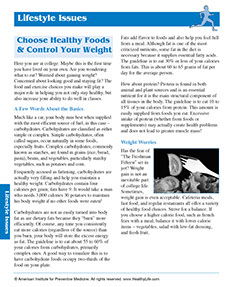CONDITIONS
SYMPTOM CHECKER
Male
Female
Child
Arm, Hand & Shoulder Concerns
Legs & Feet Concerns
Dental & Mouth Concerns
Ear & Nose
Eye Conditions
Head Conditions
Arm, Hand & Shoulder Concerns
Legs & Feet Concerns
Front
Back
Arm, Hand & Shoulder Concerns
Dental & Mouth Concerns
Ear & Nose
Eye Conditions
Head Conditions
Arm, Hand & Shoulder Concerns
Dental & Mouth Concerns
Ear & Nose
Eye Conditions
Head Conditions
Front
Back
Arm, Hand & Shoulder Concerns
Neck Links
Head & Neck Concerns
Arm, Hand & Shoulder Concerns
Neck Links
Head & Neck Concerns
Front
Back
Online Clinic
Wise Healthcare
Choose Healthy Foods & Control Your Weight
Print on Demand
Here you are at college. Maybe this is the first time you have lived on your own. Are you wondering what to eat? Worried about gaining weight? Concerned about looking good and staying fit? The food and exercise choices you make will play a major role in helping you not only stay healthy, but also increase your ability to do well in classes.
A Few Words About the Basics
Much like a car, your body runs best when supplied with the most efficient source of fuel, in this case – carbohydrates. Carbohydrates are classified as either simple or complex. Simple carbohydrates, often called sugars, occur naturally in some foods, especially fruits. Complex carbohydrates, commonly known as starches, are found in grains (rice, bread, pasta), beans, and vegetables, particularly starchy vegetables, such as potatoes and corn.
Frequently accused as fattening, carbohydrates are actually very filling and help you maintain a healthy weight. Carbohydrates contain four calories per gram; fats have 9. It would take a man who needs 3,000 calories 30 potatoes to maintain his body weight if no other foods were eaten!
Carbohydrates are not as easily turned into body fat as are dietary fats because they “burn” more efficiently. Of course, any time you consistently eat more calories (regardless of the source) than you burn, your body will store the excess energy as fat. The guideline is to eat about 55 to 60% of your calories from carbohydrates, primarily complex ones. A good way to visualize this is to have carbohydrate foods occupy two-thirds of the food on your plate.
Fats add flavor to foods and also help you feel full from a meal. Although fat is one of the most criticized nutrients, some fat in the diet is necessary because it supplies essential fatty acids. The guideline is to eat 30% or less of your calories from fats. This is about 60 to 65 grams of fat per day for the average person.
How about protein? Protein is found in both animal and plant sources and is an essential nutrient for it is the main structural component of all tissues in the body. The guideline is to eat 10 to 15% of your calories from protein. This amount is easily supplied from foods you eat. Excessive intake of protein (whether from foods or supplements) may actually create health problems and does not lead to greater muscle mass!
Weight Worries
Has the fear of “The Freshman Fifteen” set in yet? Weight gain is not an inevitable part of college life. Sometimes, weight gain is even acceptable. Cafeteria meals, fast food, and regular restaurants all offer a variety of healthy food choices. Strive for a balance. If you choose a higher calorie food, such as french fries with a meal, balance it with lower calorie items – vegetables, salad with low-fat dressing, and fresh fruit.
Don’t forget the other side of the equation which is exercise. Eating right and exercising regularly will keep you in top form. Do exercises that you enjoy. Exercise at least 3 times a week. Choose some form of aerobic exercise, such as walking, swimming, Tai (Tae) Bo, etc. Do stretching and strengthening exercises, too. For more information on exercise, access the Web site: www.fitness.gov.
Breakfast for Better Grades
Starting the day with breakfast is the key to learning. People who eat breakfast perform better on cognitive tests, have better verbal fluency, and increased memory. This may not translate into passing college chemistry, but it does give you a fighting chance.
Eating breakfast also helps you maintain weight. People who eat breakfast generally burn 4 to 6% more calories than people who do not eat breakfast.
Many students skip breakfast. It is best if you don’t. For breakfast, have whole grain cereal and milk; a breakfast sandwich on whole grain bread; yogurt with granola; cottage cheese with fresh fruit; leftover pizza, or a muffin or bagel with milk and an apple. Take a bagel or pop tart and a juice box to class with you, if you don’t set aside time to eat breakfast.
Going Vegetarian?
If you are thinking about trying a vegetarian eating style, you may not know where to begin. Vegetarianism means eating mostly plant foods. If you include dairy and egg products in your eating plan, it is easier to meet your nutrient needs. If you’re a vegan – which means you only eat plant foods – you may need to supplement your diet with calcium, iron, zinc, and vitamins B12 and D.
Start slowly. Begin by changing some of your favorite recipes – decrease meat and add more pasta, beans, rice, or vegetables. Look for vegetarian meat alternatives, like soy or veggie burgers. Experiment with different types of beans, pasta, and rice. Try red, black, navy, or pinto beans, or split peas and lentils. Look for different types of rice – from plain white to mixed brown and long grain. Top salads with chickpeas or red beans instead of cheese. You will also need to increase fluids, such as water or juices, to help with the increased fiber.
If you are looking for more information on being a vegetarian, try www.vrg.org (The Vegetarian Resource Group).
This website is not meant to substitute for expert medical advice or treatment. Follow your doctor’s or health care provider’s advice if it differs from what is given in this guide.
The American Institute for Preventive Medicine (AIPM) is not responsible for the availability or content of external sites, nor does AIPM endorse them. Also, it is the responsibility of the user to examine the copyright and licensing restrictions of external pages and to secure all necessary permission.
The content on this website is proprietary. You may not modify, copy, reproduce, republish, upload, post, transmit, or distribute, in any manner, the material on the website without the written permission of AIPM.
2021 © American Institute for Preventive Medicine - All Rights Reserved. Disclaimer | www.HealthyLife.com
















































